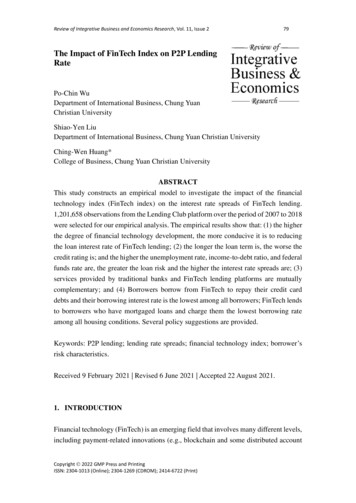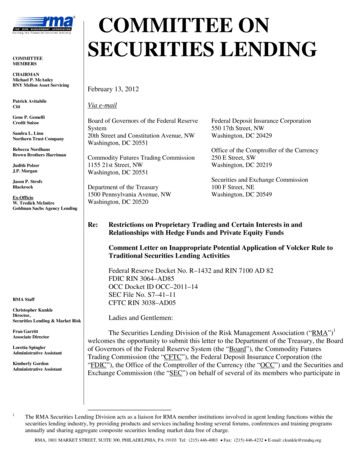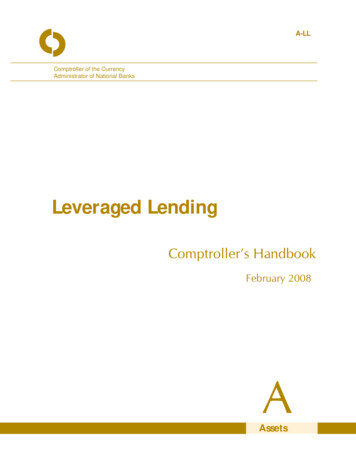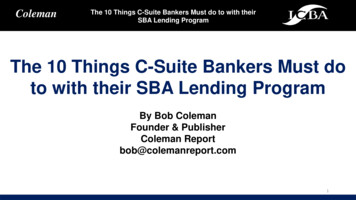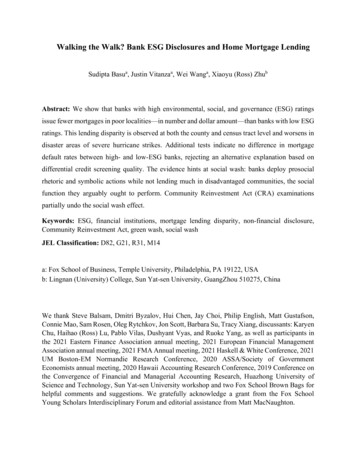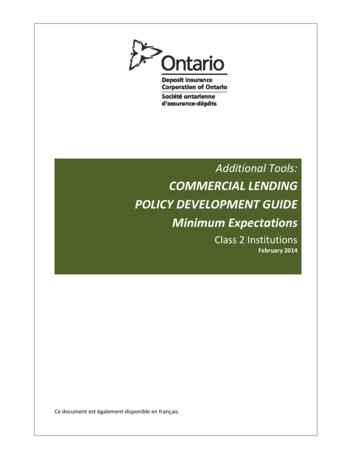
Transcription
Additional Tools:COMMERCIAL LENDINGPOLICY DEVELOPMENT GUIDEMinimum ExpectationsClass 2 InstitutionsFebruary 2014Ce document est également disponible en français.
COMMERCIAL LENDINGPOLICY DEVELOPMENT GUIDETable of Contents1.POLICY STATEMENT AND GUIDING PRINCIPLES. 22.AUTHORIZED COMMERCIAL LENDING PRODUCTS. 43.LENDING LIMITS . 44.LENDING CRITERIA. 55.CREDIT RISK RATING. 66.PORTFOLIO DIVERSIFICATION . 67.SYNDICATED LOANS . 78.LARGE EXPOSURES . 79.LOANS TO CONNECTED AND RELATED PARTIES. 810.LOANS TO RESTRICTED PARTIES . 811.PROCEDURES AND CONTROL SYSTEMS . 912.SECURITY. 1013.LOAN APPROVALS AND AUTHORIZED LENDING LIMITS . 1114.POLICY EXCEPTIONS . 1115.WATCH LIST ACCOUNTS . 1216.DELINQUENT AND IMPAIRED LOANS . 1217.RE‐WRITTEN/RESTRUCTURED COMMERCIAL LOANS . 1218.WRITE‐OFFS . 1319.REPORTING . 1320.POLICY APPROVAL AND REVIEW . 13Throughout this document, the term “credit union” also refers to “caisse populaire” and “league”.Additional Tools: Commercial Credit Policy Development Guide for Class 2 Institutions1
COMMERCIAL LENDINGPOLICY DEVELOPMENT GUIDE1.POLICY STATEMENT AND GUIDING PRINCIPLESThe policy statement and guiding principles set out the general approach and fundamentalexpectations for commercial lending activities. They set out the framework for commerciallending which should be aligned with risk appetite, risk tolerance and the risk profile of thecredit union as defined in the board approved Enterprise Risk Management (ERM) policy.Please refer to the ERM Guidance Note, Application Guide and ERM Framework documenton DICO’s website for more information on risk appetite and risk tolerance.Policy StatementThe policy statement should state the purpose of developing and maintaining prudentcommercial lending policies. Policies should comply with prudent business practices andcontrols to manage commercial credit risk in line with the credit union’s risk appetite. Itshould delegate responsibility to management, subject to any restrictions, limitations andrequirements as set out.Guiding PrinciplesThis section would generally provide an overview of the underlying philosophy, frameworkand approach for commercial lending.a) Lending philosophy outlines the: responsibility of the board and management for safeguarding the assets of the creditunion, while providing loans to members at competitive rates sufficient to generaterevenues to ensure profitability.minimum characteristics and qualities of borrowers such as:o businesses which operate in a manner that reflects the values of the institutionand its membership;o strong financial soundness and capacity to repay;o good track record of financial management;o appropriate management expertise, ando acceptable forms of security.b) Lending framework, procedures and authorities describe: the establishment and maintenance of a disciplined framework for commercialcredit lending activities;Additional Tools: Commercial Credit Policy Development Guide for Class 2 Institutions2
the Board’s risk appetite and risk tolerances being appropriately considered bymanagement in creating and updating commercial lending operational policies andprocedures;the requirement that operational policies be regularly reviewed by the internalauditor for appropriateness and confirmation of adherence to both corporate andoperational policies;the delegation of responsibility to management for:o identifying, quantifying, controlling, mitigating and reporting on credit risk ‐ someexamples of items to be included in the reporting are: loan origination results (application volume, approval rates, etc.; overall portfolio size and diversification in comparison to the creditunion’s Risk Appetite; individual situations that are not in compliance with the terms of theauthorized credit; delinquency and impaired accounts.o prudently managing exposure to potential default and loss;o ensuring that appropriately qualified staff are assigned to implement riskmeasurement and commercial credit risk management processes; ando ensuring appropriate segregation of duties and responsibilities.c) Risk Management principles requiring: sufficient diversification within the commercial loan portfolio to mitigateconcentration risk;sufficient qualified risk assessment based on established lending criteria in line withthe size, security and term of the loan;updated risk ratings be assigned for all new and regularly updated for outstandingloans;loans meet minimum assessment criteria and risk rating;the borrower to be fully informed of the terms and conditions of the loan prior tosigning loan agreements;security documents that clearly record:o terms, rates, fees and penalties;o financial and reporting covenants;o the type of financial statements to be provided by the borrower (for example,prepared “in house”, auditor prepared with or without review, consolidated,etc.).the performance of appropriate annual commercial credit reviews and riskassessments commensurate with the size and level of risk for each loan.d) Compliance requirements that adhere to: all regulatory requirements and DICO’s By‐law No. 5 ‐ Standards of Sound Businessand Financial Practices and By‐law No. 6 – Reserves and Monthly Provision forDoubtful Loans, and related Guidance Notes; andAdditional Tools: Commercial Credit Policy Development Guide for Class 2 Institutions3
2.the delegation of lending authority for management and staff, and the basis ofauthority granted to each level of staff (e.g., experience, ability, education).AUTHORIZED COMMERCIAL LENDING PRODUCTSThis section should identify the lending products that the credit union will offer to itscommercial members. The type of commercial loans granted should be reflective of the sizeand complexity of the credit union, its lending capabilities, risk appetite, tolerance andunderwriting ability and experience.These would typically include items such as: 3.mortgages, term loans, operating lines of creditconstruction mortgagesReal estate and rental propertiesletters of creditsyndicated loansleasesLENDING LIMITSCredit unions are required to establish and implement prudent lending limits. Policy limitsshould take into account the: knowledge and expertise of management and staff;business environment in which the credit union operates;credit union’s risk tolerance; andstrength of the credit union’s capital (ability to absorb losses).Maximum lending limits to individual and connected parties must be in compliance withlimits prescribed in the Credit Unions and Caisses Populaires Act, 1994 (the “Act”) andOntario Regulation 237/09 (the “Regulation”).The policy should establish overall lending limits and restrictions, including: limits for loans in aggregate to any one borrower or group;the maximum size of a single loan by type:o maximum amount of a loan either as a dollar limit or as a percentage ofregulatory capital reported on their last audited financial statement; ando lending limit for each type of loan.concentration limits by industry and loan type;aggregate limits of large loans;loan to value ratios;overall portfolio risk levels;Additional Tools: Commercial Credit Policy Development Guide for Class 2 Institutions4
4.requirement to obtain prior board approval for any loan to a Restricted Party and allexceptions to underwriting criteria and restrictions; andrequirement for all lending limits to be reviewed at least annually.LENDING CRITERIAThis section outlines appropriate underwriting criteria that should be established andmaintained, including: lending criteria and security requirements that are appropriate, prudent and alignedwith standard industry practices;minimum criteria and limits that must be met by the borrower before a loan can begranted, such as:o Credit worthiness/credit rating of borrower;o Financial position (profitability; financial performance);o Financial performance indicators (ratios);o Stress testing of ability to pay (applying higher interest rates/terms);o Risk rating level;o Nature of business;o Completion of appraisals as per standards outlined in the policy;o Completion of assessments (environmental and any others, as required)o Quality of managemento Prospects for success of the business; ando Other “know your client” requirements, including Anti‐Money Launderingprovisions.documentation required for granting commercial loans;analysis of borrower’s financial position and capacity to repay the loan;lease analysis (type of lease, maturity dates and stress testing if tenant vacates); andjustification for underwriting decision on the basis of financial analysis and otherrelevant criteria.For credit unions involved in construction developments, land assemblies and land banking(vacant land), additional items to be included are: use of expert opinions with reference to market/feasibility studies;use of project monitors or quality surveyors;conduct due diligence including:o requiring Electrical Safety Authority (ESA) report(s) on electrical safety;o necessary approvals from appropriate government bodies (e.g. building permits,zoning approvals, easements, etc.);o obtaining executed leases;o requiring an ethical review;o requiring more frequent monitoring or interim reporting prior to the annualreview; ando other prudent due diligence requirements the credit union may wish to include.Additional Tools: Commercial Credit Policy Development Guide for Class 2 Institutions5
5.Progress draw/holdback procedures (required to protect against liens registeredunder the Construction Lien Act).CREDIT RISK RATINGA credit risk rating system provides a standard by which to measure the level of risk of aloan and the loan portfolio.This section should identify the: 6.responsibilities of management in developing and maintaining a credit risk ratingsystem;risk rating methodology used;timing and frequency of risk rating:o at the time of application for all new or increased loan facilities;o as part of the annual review process; ando in situations where new information is considered that may materially affect thecredit risk of the loan.number of rating levels and the criteria for each rating;Board’s target risk rating for the various loan categories and aggregate loanportfolio;requirement to report the aggregate risk rating of the portfolio or portions withinthe portfolio to the board; andcontent and frequency of Board reporting including strategies to resolve anyexceptions.PORTFOLIO DIVERSIFICATIONIt is important to maintain an appropriate and prudent portfolio diversification in order tomitigate risk and avoid excessive risk exposure.The policy should identify the: target maximum concentration levels for each category within the portfolio( and %);target maximum geographic concentration levels;requirement and responsibility for monitoring of the loan portfolio;nature, content and frequency of Board reporting; andrequirement for Board approval of any excess positions.Additional Tools: Commercial Credit Policy Development Guide for Class 2 Institutions6
7.SYNDICATED LOANSWhile the syndicating credit union undertakes the credit risk evaluation and on‐goingmonitoring and administration of the loan on behalf of all parties, all participating creditunions in the syndicate are required to undertake their own initial and on‐going credit riskevaluation of the loan, as they would for any other loan of a similar nature including regularsite reviews, where appropriate. Each credit union participating in the loan syndicationmust ensure compliance with the requirements of section 190 of the Act and section 56 ofthe Regulation.Please refer to DICO Lending Advisory #2: “Authorized Participants in Loan Syndication”(issued October 2011)The policy should identify the: maximum limits for syndicated loans; requirement for a formal syndication agreement with the syndicating credit union; requirement for the borrower to be a member of an Ontario credit union that is oneof the lenders in the loan syndicate; requirement for the credit union to conduct due diligence of the syndicator withrespect to financial soundness; requirement that the syndicating credit union’ s lending policy and practices andassessment criteria be as comprehensive and stringent as that of the credit union; requirement that the credit union, following its own analysis, review and confirm theresults of the underwriting for the loan; requirement for an initial and on‐going credit risk evaluation and risk rating of theloan in accordance with normal lending criteria; requirement to conduct regular site reviews where applicable; and nature, content and frequency of Board reporting.8.LARGE EXPOSURESEstablishing aggregate limits for large exposures helps mitigate concentration risk. Forexample, too many high value loans within the loan portfolio may cause a funding shortfallfor member loan demand or a significant loss to the credit union if the loan becomesuncollectible. Apart from establishing general lending limits for commercial loans, the policyshould also address large exposures.This should include: establishing thresholds for large exposures;setting limits for large exposures;setting aggregate limits for large exposures;establishing the frequency and extent for monitoring large exposures; andestablishing the content and frequency of Board reporting requirements.Additional Tools: Commercial Credit Policy Development Guide for Class 2 Institutions7
Monitoring of large exposures should be more frequent and extensive than lower valueloans. For example, it may be more prudent to review all large exposures every six monthsrather than the recommended annual review. The review frequency for different sizes andtypes of loans needs to be detailed in the policy supported with the appropriate businessrules.9.LOANS TO CONNECTED AND RELATED PARTIESSection 67 of the Regulation sets out the conditions where individuals and entities areconsidered to be connected persons. Credit unions should also consider the following whenestablishing prudent lending limits for connected and related parties and adherence tomaximum regulatory single and aggregate lending limits: A connection generally exists where two or more entities share a common risk. Theexposures to the entities comprising a connection should be aggregated for thepurpose of applying limits on the credit union’s large exposures;Common risk will generally occur where the entities are part of a corporate groupand there is material financial interdependence between the entities;A corporate group includes an entity and all of its subsidiaries, whether they areowned directly or indirectly;Financial interdependence should be assessed taking into considerationintercompany funds movement and contractual agreements, including commonsecurity arrangements, guarantees and letters of comfort;A person or entity that provides a guarantee for a borrower should be treated as aconnected person to the borrower regardless of whether any specific tangiblesecurity is pledged to support the guarantee.The policy should set out the: aggregate loan limits to connected persons and related parties;underwriting guidelines for loans to connected persons and related parties;requirement for identifying and monitoring connected person and related partyloans;approval levels required to grant loans to connected persons and related parties;andnature and frequency of Board reporting of connected and related party loans.10. LOANS TO RESTRICTED PARTIESIt is important for institutions to identify full requirements surrounding restricted partyloans including loans to officers, directors and staff or commercial entities. Credit unionsmust comply with the requirements set out in Part X of the Credit Union and CaissesPopulaires Act. The credit union’s conflict of interest policy should also be reflected in itslending policy.Additional Tools: Commercial Credit Policy Development Guide for Class 2 Institutions8
This section should include: a comprehensive definition of restricted parties;lending limits applicable to restricted parties;the requirement for prior Board approval of any restricted party loan; andthe nature and frequency of Board reports on restricted party loans.11. PROCEDURES AND CONTROL SYSTEMSFundamental requirements and standards should be set out for an integrated system ofoperational policies, procedures and sound business practices in commercial lending at thecredit union.This section should address the following key requirements regarding:Process: adhering to an established, documented loan underwriting process which definesthe appropriate steps to adjudicate the loan from application through approval andfunding;underwriting and approving loans should be made by appropriately qualified staff,with appropriate authorization and accountability;delegating formal lending limits to lending staff in accordance with their skills,qualifications and experience;maintaining proper documentation of loan applicant information and credit analysisand decisions made according to defined criteria;aligning loan applications with established credit granting criteria that:o determine the borrower’s ability, capacity and willingness to pay; ando ensure that underwriting criteria meet the institution’s standards for loanapproval.obtaining proper security and registration documentation;ensuring that there is separation of duties with respect to the loan beingunderwritten, approved and funded (e.g. the lending officer underwrites the loan,another individual approves the loan and another individual disburses the funds tothe borrower); andmaking loan disbursements only through proper channels as defined by the creditunion.Control: establishing monitoring and control procedures that are maintained by managementto ensure the appropriate disbursement of loans;Additional Tools: Commercial Credit Policy Development Guide for Class 2 Institutions9
ensuring the implementation and maintenance of a credit portfolio managementsystem by which loans are appropriately recorded, payments are collected andrecorded when due, arrears are noted in a timely manner and regular periodicreports are issued;Monitoring:Note: Inadequate timely monitoring and the non‐implementation of appropriate andprompt corrective action are primary causes of commercial loan losses. establishing and maintaining a reporting system which provides adequateinformation to allow an effective assessment of the loan portfolio on a periodicbasis, including the monitoring of trends within the portfolio;implementing and maintaining a modeling and stress testing program for theportfolio (dependant on the size of the credit union) and regularly reporting theresults to the Board;reviewing the commercial loans and commercial lending portfolio at least annually,and in some cases such as construction financing, more frequently, whereby thelevel of risk is assessed, leading to adjustments in specific loan provisions andincreased diligence in monitoring of commercial loans as required;establishing the extent of the loan review which is dependent on the risk profile ofthe loan;monitoring of approvals to ensure they are in line with approval limits andunderwriting criteria;establishing a requirement for increased frequency of reporting in instances wherethe risk of a loan has increased (i.e., where the quality of the loan has deteriorated),reflecting the risk appetite and tolerance related to commercial loan performanceand the type of loan product; andestablishing and maintaining a monthly out‐of‐order report that itemizes and tracksall loans, with all exceptions to authorized credit terms, the length of time thesituation has been outstanding (number of times reported) and the steps beingtaken to address the out of order issue. This report should be provided to the seniormanagement and the board on a monthly basis.12. SECURITYSecurity is an important aspect in the mitigation of risk of every loan.This section should address the: conditions where security is required for a loan;value and nature of the security that should be requested;Additional Tools: Commercial Credit Policy Development Guide for Class 2 Institutions10
details of eligible security by loan type and category;requirement for the security obtained to be registered and safeguarded prior to loanadvancement;requirement that the security accepted should be sufficient and reflect the riskappetite and risk tolerance of the credit union; andrepayment terms of the loan should be such that the loan to value ratio improvesover the term of the loan, especially where the market value of the security maydepreciate over time.13. LOAN APPROVALS AND AUTHORIZED LENDING LIMITSApprovals:The manner in which loans will be evaluated and approved and how decisions will beescalated should be indicated in this section that identifies: management as being delegated the responsibility to document a loan approvalhierarchy in operational procedures;approval limits that are commensurate to the qualifications, experience andbackground of lending staff;the dollar amount, type and complexity of loans; andall loans that can be made within the lending limits specified by this policy.Authorized Lending Limits:This section, usually presented in a tabular format, should set out: each category and type of commercial loan the credit union will underwrite; andthe corresponding lending limits, in dollar amount for designated lending staff andmanagement, including joint limits for large loans.14. POLICY EXCEPTIONSThis section addresses the granting and approving of loans which are outside the lendinglimits, authorities or other parameters defined by the commercial lending policy andsupporting underwriting criteria, or considered to be out of order.This section should include the: process for obtaining the approval;documentation requirements of the Board for approval;requirement that the loans be regularly monitored by management;nature, content and frequency of Board reporting; andrequirement that all post funding exceptions to policy require Board (or whereappropriate, Credit Committee) approval.Additional Tools: Commercial Credit Policy Development Guide for Class 2 Institutions11
15. WATCH LIST ACCOUNTSThis section identifies the criteria and limits for placing a loan on the watch list. These limitsshould reflect the level of risk appetite and risk tolerance of the credit union.Specifically, this section should address the: situation or status that qualifies a loan to be placed on the watch list, which shouldinclude:o deteriorating or lack of current financial information;o covenant breaches (e.g., earnings shortfall or losses);o potential security shortfalls (e.g., asset sale, loss or damage, fraud);o potential debt service shortfalls (e.g., significant revenue decline); ando significant adverse developments (e.g., restructuring, unexpected managementdepartures, loss of major customer, legal action, etc., labour dispute/strike, newcompetition).requirement for approvals to place loans on the watch list;content of monitoring reports including corrective action to bring the loan on side;responsibility for reporting; andnature, content and frequency of Board reporting.16. DELINQUENT AND IMPAIRED LOANSThis section should set out the requirements to establish procedures to actively managedelinquent and impaired loans with the objective of avoiding loss or mitigating the risk.This section should specify the: characteristics that define a delinquent or impaired loan (timing of last contractualpayment, credit deterioration and other factors the credit union deems important);responsibilities of management for monitoring and collecting impaired loans;requirements and authorization for loan provisions; andnature, content and frequency of the Board reporting.17. RE‐WRITTEN/RESTRUCTURED COMMERCIAL LOANSIn exceptional circumstances, commercial loans may be re‐written to allow the borrower tocontinue to service the loan. This may include changing of one or more of the conditions ofthe loan.This section of the policy should include the: definition of a rewritten or restructured loan;criteria under which a loan can be re‐written or restructured;authorities required to approve the loan;requirement by management to monitor and follow‐up on these loans;nature, content and frequency of Board reporting; andAdditional Tools: Commercial Credit Policy Development Guide for Class 2 Institutions12
criteria under which provisions for loss can be removed for rewritten or restructuredloans.18. WRITE‐OFFSThe purpose of write‐offs is to recognize the diminished or reduced value of a loan once it isdeemed to be uncollectible in whole or part.This section should specify the: conditions under which a loan will be wholly or partially written off;write‐off authority and approval levels; andnature, content and frequency of Board reporting.19. REPORTINGComprehensive, timely and accurate reporting is important to allow the Board to fulfill itsoversight responsibilities and ensure that: the level of risk taken by the credit union is in keeping with the established riskappetite;sufficient due diligence is taking place over monitoring and managing loandelinquency; andthe growth and composition of the loan portfolio is in keeping with the institution’sstrategic plan.This section of the policy should indicate the: requirement for management to report the performance of the commercial loanportfolio to the Board, on both an individual loan and portfolio basis;nature and content of reports required by the Board; andfrequency of each required report.20. POLICY APPROVAL AND REVIEWPolicies are reviewed to ensure they appropriately reflect changes in the operations of thecredit union, the Act, Regulation, DICO By‐Laws or the credit union’s by‐laws.This section would identify the: requirement of the Board (and management) to conduct policy reviews;role of Board and management in updating and reviewing policies;frequency of policy reviews;additional conditions that might trigger a policy review;required analysis and impact on risk exposure of any material changes to policy; andrequirement for Board approval for changes to policies.Additional Tools: Commercial Credit Policy Development Guide for Class 2 Institutions13
the delegation of lending authority for management and staff, and the basis of authority granted to each level of staff (e.g., experience, ability, education). 2. AUTHORIZED COMMERCIAL LENDING PRODUCTS This section should identify the lending products that the credit union will offer to its
